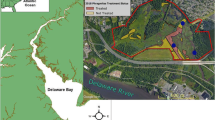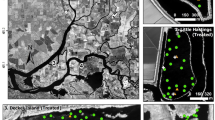Abstract
Recreational boating is widely recognized as an important vector for overland transport of invasive aquatic plants. Since their dominant form of recruitment is vegetative reproduction, entangled fragments on boats and trailers can establish new populations. The effectiveness of recreational boats as transport vectors relies on the resistance of macrophytes to air exposure. During the summers of 2012 and 2013, we conducted five field experiments in northern Wisconsin to assess air tolerance of Eurasian water-milfoil (Myriophyllum spicatum) and curly-leaf pondweed (Potamogeton crispus). We simulated conditions that these plants would experience when ensnared on boats and trailers by testing viability after drying of single stems, coiled stems, and vegetative buds (turions). Single stems of M. spicatum and P. crispus were viable for up to 18 and 12 h of air exposure, respectively. Coiling extended the viability of M. spicatum to 48 h of air exposure. Turions of P. crispus successfully sprouted after 28 days of drying. The fact that recreational boaters in the region typically visit multiple lakes within a few days suggests that most lakes are susceptible to introduction of viable plants, and so lake managers should continue to focus attention on boat cleaning.



Similar content being viewed by others
References
Barnes, M. A., C. L. Jerde, D. Keller, W. L. Chadderton, J. G. Howeth & D. M. Lodge, 2013. Viability of aquatic plant fragments following desiccation. Invasive Plant Science and Management 6: 320–325.
Boylen, C. W., E. W. Lawrence & J. D. Madsen, 1999. Loss of native aquatic plant species in a community dominated by Eurasian water-milfoil. Hydrobiologia 415: 207–211.
Carpenter, S. R. & D. M. Lodge, 1986. Effects of submerged macrophytes on ecosystem processes. Aquatic Botany 26: 341–370.
Center for Invasive Species and Ecosystem Health, 2013. Invasive and exotic aquatic plants. Retrieved December 20, 2013 from [http://www.invasive.org/species/aquatic.cfm].
Evans, C. A., D. L. Kelting, K. M. Forrest & L. E. Steblen, 2011. Fragment viability and rootlet formation in Eurasian watermilfoil after desiccation. Journal of Aquatic Plant Management 48: 57–62.
Havel, J. E. & J. Stelzleni-Schwent, 2000. Zooplankton community structure: the role of dispersal. Internationale Vereinigung fü rtheoretische und angewandte Limnologie 27: 3264–3268.
Horsch, E. J. & D. J. Lewis, 2009. The effects of aquatic invasive species on property values: evidence from a quasi-experiment. Land Economics 85: 391–409.
Jerde, C., M. A. Barnes, E. K. DeBuysser, A. Noveroske, W. L. Chadderton & D. M. Lodge, 2012. Eurasian Water-milfoil fitness loss and invasion potential following desiccation during simulated overland transport. Aquatic Invasions 7: 135–142.
Jian, Y., B. Li, J. Wang & J. Chen, 2003. Control of turion germination in Potamogeton crispus. Aquatic Botany 75: 59–69.
Johnson, L. E. & J. T. Carlton, 1996. Post-establishment spread in large-scale invasions: dispersal mechanisms of the zebra mussel Dreissena polymorpha. Ecology 77: 1686–1690.
Johnson, L. E., A. Ricciardi & J. T. Carlton, 2001. Overland dispersal of aquatic invasive species: a risk assessment of transient recreational boating. Ecological Applications 11: 1789–1799.
Johnstone, L. M., R. T. Coffey & C. Howard-Williams, 1985. The role of recreational boat traffic in interlake dispersal of macrophytes: a New Zealand case study. Journal of Environmental Management 20: 263–279.
Joyce, J. C., 1992. The introduced aquatic macrophyte, Myriophyllum spicatum, as habitat for fish and their invertebrate prey. Impact of Eichornia and Hydrilla in the United States 194: 106–109.
Keast, A., 1983. The introduced aquatic macrophyte, Myriophyllum spicatum, as habitat for fish and their invertebrate prey. Canadian Journal of Zoology 62: 1289–1303.
Madsen, J. D., L. W. Eichler & C. W. Boylen, 1988. Vegetative spread of Eurasian watermilfoil in Lake George, New York. Journal of Aquatic Plant Management 26: 47–50.
Madsen, J. D., J. W. Sutherland, J. A. Bloomfield, L. W. Eichler & C. W. Boylen, 1991. The decline of native vegetation under dense Eurasian watermilfoil canopies. Journal of Aquatic Plant Management 29: 94–99.
McAlarnen, L. A., M. A. Barnes, C. L. Jerde & D. M. Lodge, 2012. Simulated overland transport of Eurasian watermilfoil: survival of desiccated plant fragments. Journal of Aquatic Plant Management 50: 147–149.
Pimentel, D., R. Zuniga & D. Morrison, 2005. Update on the environmental and economic costs associated with alien-invasive species in the United States. Ecological Economics 52: 273–288.
Riis, T., T. Madsen & R. S. Sennels, 2009. Regeneration and colonization and growth rates of all fragments in four common stream plants. Aquatic Botany 90: 209–212.
Rogers, K. H. & C. M. Breen, 1980. Growth and reproduction of Potamogeton crispus in a South African lake. Ecology 68: 561–571.
Rothlisberger, J. D., W. L. Chadderton, J. McNulty & D. M. Lodge, 2010. Aquatic invasive species transport via trailered boats: what is being moved, who is moving it, and what can be done. Fisheries 35: 121–132.
Ruiz, G. M. & J. T. Carlton, 2003. Invasive species: vectors and management strategies. Island Press, Washington, DC.
Simberloff, D., 2009. The role of propagule pressure in biological invasions. Annual Review Ecology, Evolution, and Systematics 40: 81–102.
United States Department of Agriculture National Agricultural Library, 2012. Invasive species. Retrieved February 5, 2013 from [http://www.invasivespeciesinfo.gov/aquatics/pondweed].
Vander Zanden, J. M. & J. D. Olden, 2008. A management framework for preventing the secondary spread of aquatic invasive species. Canadian Journal of Fisheries and Aquatic Sciences 65: 1512–1522.
Wisconsin Department of Natural Resources, 2013a. Aquatic Invasive Species. Retrieved February 5, 2013 from [http://dnr.wi.gov/lakes/invasives].
Wisconsin Department of Natural Resources, 2013b. The Handbook of Wisconsin Boating Laws and Responsibilities. Wisconsin Department of Natural Resources, Madison, WI.
Woolf, T. E. & J. D. Madsen, 2003. Seasonal biomass and carbohydrate allocation patterns in southern Minnesota curlyleaf pondweed populations. Journal of Aquatic Plant Management 41: 113–118.
Zhang, C. & K. Boyle, 2010. The effect of an aquatic invasive species (Eurasian water-milfoil) on lakefront property values. Ecological Economics 70: 394–400.
Acknowledgments
We thank M. Lenhardt and A. Gemberling for assistance with collections and experiments, K. Morrison and T. Meinke for constructing the weather station, and A. Latzka and anonymous reviewers for comments on the manuscript. Logistical support was provided by the UW Trout Lake research station and financial support by a grant from the Wisconsin Department of Natural Resources (AEPP-305-11).
Author information
Authors and Affiliations
Corresponding author
Additional information
Guest editors: Sidinei M. Thomaz, Katya E. Kovalenko, John E. Havel & Lee B. Kats / Aquatic Invasive Species
Rights and permissions
About this article
Cite this article
Bruckerhoff, L., Havel, J. & Knight, S. Survival of invasive aquatic plants after air exposure and implications for dispersal by recreational boats. Hydrobiologia 746, 113–121 (2015). https://doi.org/10.1007/s10750-014-1947-9
Received:
Revised:
Accepted:
Published:
Issue Date:
DOI: https://doi.org/10.1007/s10750-014-1947-9




